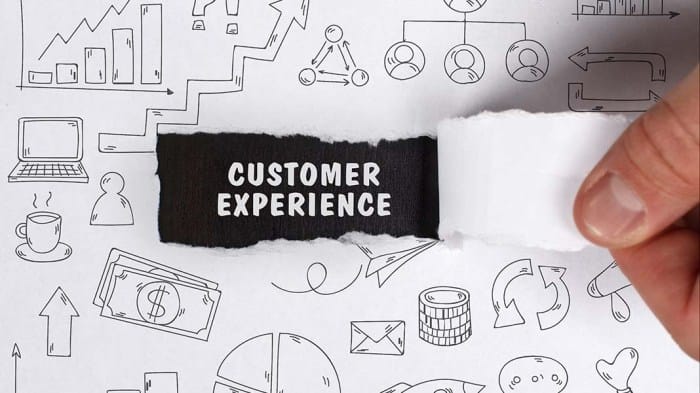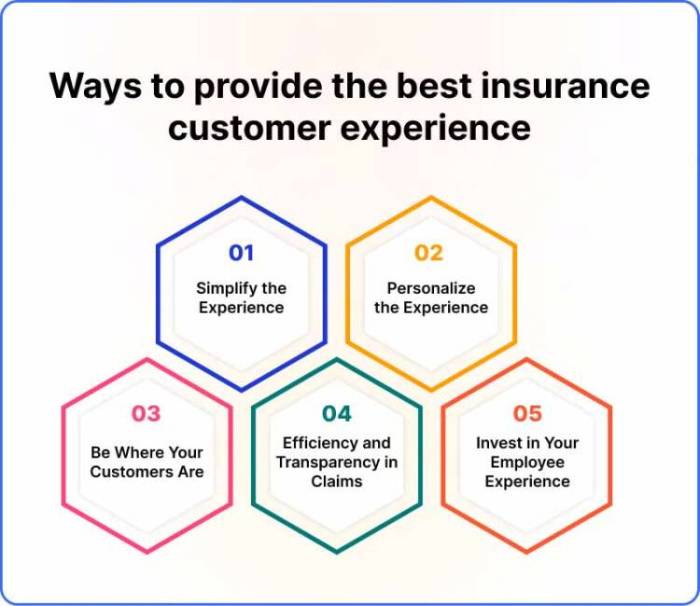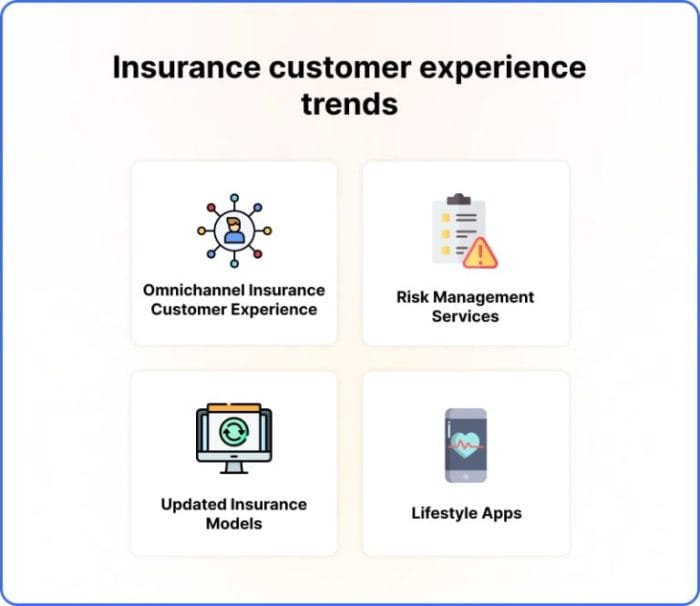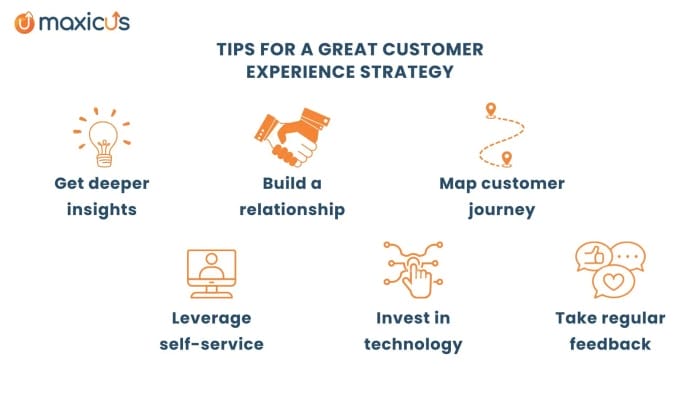In the dynamic insurance landscape of 2018, customer experience has emerged as a pivotal differentiator, shaping the success and reputation of insurance providers. This article presents 10 essential tips for insurance companies to elevate customer experience, fostering loyalty and driving growth.
With the rise of digitalization and evolving customer expectations, insurance companies must adapt and innovate to deliver exceptional experiences. By prioritizing customer needs, personalizing services, and leveraging technology, insurers can create a seamless and satisfying journey for their policyholders.
Customer-Centric Approach

In the insurance industry, where competition is fierce and customer expectations are continuously evolving, adopting a customer-centric approach is paramount. Prioritizing customer needs and satisfaction should be at the core of every insurance provider’s strategy.
By embracing a customer-centric approach, insurance companies can significantly enhance customer retention and loyalty. Satisfied customers are more likely to renew their policies, recommend the company to others, and provide valuable feedback for improvement.
Benefits of a Customer-Centric Approach
- Improved Customer Retention: By focusing on customer satisfaction, insurance companies can reduce churn and increase customer retention rates. Satisfied customers are more likely to stay with their current provider, leading to increased revenue and profitability.
- Increased Customer Loyalty: A customer-centric approach fosters customer loyalty by creating positive experiences and building strong relationships. Loyal customers are more likely to be advocates for the company, providing positive word-of-mouth and referrals.
- Enhanced Brand Reputation: A company that consistently delivers exceptional customer experiences will build a strong brand reputation for excellence. A positive reputation attracts new customers and reinforces loyalty among existing ones.
- Valuable Customer Feedback: Satisfied customers are more likely to provide feedback and suggestions for improvement. This valuable input helps insurance companies identify areas where they can enhance their products, services, and processes.
Personalization and Customization
The insurance industry has long operated on a one-size-fits-all approach, but this is changing rapidly. Customers today expect their insurance policies and services to be tailored to their individual needs and preferences. Personalization and customization are essential for delivering a superior customer experience in the insurance industry.
Insurance companies can leverage data and technology to gather insights into their customers’ needs and preferences. This data can then be used to develop personalized insurance policies and services that meet the unique needs of each customer. For example, an insurance company might offer a discount to customers who install smart home security systems or who have a history of safe driving.
Benefits of Personalization and Customization
- Increased customer satisfaction: Customers are more likely to be satisfied with their insurance policies and services if they feel that they are tailored to their individual needs.
- Improved customer retention: Personalized insurance policies and services can help to improve customer retention by making customers feel more valued and appreciated.
- Increased sales: Personalized insurance policies and services can help to increase sales by making them more appealing to customers.
- Improved efficiency: Personalization and customization can help insurance companies to improve their efficiency by streamlining their processes and reducing the amount of time spent on manual tasks.
Examples of Personalization and Customization
- Usage-based insurance: Usage-based insurance policies are tailored to the individual driving habits of the policyholder. The premium is based on the number of miles driven, the time of day driven, and the location of the driving.
- Telematics: Telematics devices can be installed in vehicles to track driving habits. This data can then be used to provide personalized feedback to drivers and to offer discounts for safe driving.
- Loyalty programs: Loyalty programs can be used to reward customers for their business. Rewards can include discounts on premiums, free gifts, and access to exclusive services.
Seamless Digital Experience

In today’s digital age, insurance customers expect a seamless and user-friendly online experience. This means creating a website and mobile app that is easy to navigate, provides comprehensive information, and allows customers to easily manage their policies and claims.
There are a number of innovative digital tools and platforms that can help insurance companies improve the customer experience. These include:
Chatbots and virtual assistants:
- These tools can provide customers with immediate assistance, answer questions, and help them find the information they need.
Self-service portals:
- These portals allow customers to manage their policies, file claims, and make payments online.
Mobile apps:
- Mobile apps provide customers with a convenient way to access their insurance information and manage their policies on the go.
Online claims processing:
- This allows customers to file claims online, upload supporting documentation, and track the status of their claims.
Proactive Communication and Transparency

Proactive communication is essential for insurance companies to build trust and foster positive customer relationships. It involves主动地 communicating with customers throughout the insurance lifecycle, keeping them informed about their policies, claims, and any changes that may affect them. Transparency is also key, as customers appreciate companies that are honest and upfront about their policies, procedures, and fees.
Regular Communication
Insurance companies should communicate with customers regularly, even if there are no immediate issues or changes to report. This can be done through email, phone calls, or social media. Regular communication helps to keep customers engaged and shows that the company is invested in their satisfaction.
Efficient Claims Handling

In the insurance industry, the claims process is a crucial touchpoint that significantly influences customer satisfaction. Efficient and timely claims handling is paramount to ensuring policyholders feel valued, supported, and confident in their insurance coverage.
To streamline claims processing and minimize customer inconvenience, insurance providers should adopt best practices such as:
Simple and Accessible Claims Reporting
- Providing multiple channels for claims reporting, including online portals, mobile apps, and dedicated phone lines, to make it easy for customers to file claims.
- Simplifying claim forms and instructions to reduce the risk of errors and delays.
Prompt Claim Acknowledgment and Communication
- Acknowledging claims promptly and providing customers with a clear timeline for the claims process.
- Keeping customers informed of the claim’s progress through regular communication via email, text, or phone calls.
Thorough Claims Investigation and Assessment
- Conducting thorough investigations to gather all necessary information and evidence to accurately assess claims.
- Using technology, such as AI and data analytics, to streamline the assessment process and identify potential fraud.
Fair and Timely Claim Settlement
- Settling claims fairly and promptly, adhering to the terms and conditions of the insurance policy.
- Providing clear explanations of claim decisions to customers and addressing any concerns they may have.
Multichannel Customer Support

In the insurance sector, catering to diverse customer preferences is crucial. Offering multichannel customer support enables insurers to provide seamless experiences across various platforms, enhancing customer satisfaction and loyalty.
An effective omnichannel strategy integrates multiple communication channels, ensuring a consistent and personalized experience for customers. This approach allows customers to seamlessly switch between channels, whether it’s through phone calls, emails, social media, or mobile applications, without compromising the quality of service.
Examples of Effective Omnichannel Strategies
- Seamless Integration: Ensure that customer data and preferences are synchronized across all channels, allowing customer service representatives to access relevant information regardless of the channel used.
- Personalized Experience: Tailor interactions based on customer preferences and previous interactions. For instance, if a customer has previously contacted through social media, provide the option to continue the conversation on the same platform.
- 24/7 Availability: Offer support through multiple channels 24/7 to accommodate customers’ varying schedules and needs.
Employee Training and Empowerment

Investing in employee training and development is essential for enhancing customer service skills. When employees possess the knowledge and skills to effectively serve customers, they can provide exceptional customer experiences, leading to increased customer satisfaction, loyalty, and positive word-of-mouth.Training programs should focus on developing employees’ communication, problem-solving, and empathy skills.
Employees should be trained to understand customer needs and expectations, actively listen to customer concerns, and provide personalized solutions. Additionally, training should emphasize the importance of maintaining a positive attitude and demonstrating empathy towards customers, even in challenging situations.
Successful Training Programs
Some successful employee training programs include:
- Role-playing exercises: Employees practice interacting with customers in simulated scenarios, allowing them to develop their communication and problem-solving skills.
- Customer feedback analysis: Employees review customer feedback to identify areas where they can improve their service. This helps them understand customer expectations and tailor their approach accordingly.
- Mentoring and coaching: Experienced employees mentor new hires, providing guidance and support to help them develop their skills and knowledge.
- Online training modules: Employees can access online training modules to learn at their own pace and reinforce their understanding of customer service concepts.
By empowering employees with the necessary skills and knowledge, insurance companies can create a customer-centric culture where employees are motivated to deliver exceptional customer experiences.
Feedback Collection and Analysis

Customer feedback is a treasure trove of insights that can help insurers refine their products, services, and overall customer experience. By actively seeking and analyzing customer feedback, insurers can identify areas for improvement, address pain points, and enhance customer satisfaction.
Here are some tips for effectively collecting and analyzing customer feedback to drive positive change:
Customer Surveys
- Targeted Surveys: Design surveys that are tailored to specific customer segments or touchpoints to gather targeted feedback.
- Multiple Formats: Offer surveys in various formats, such as online, email, phone, or in-person, to accommodate customer preferences.
- Clear and Concise: Keep surveys short and focused, asking clear and concise questions that are easy to understand.
Customer Feedback Platforms
- Online Platforms: Create dedicated online platforms where customers can provide feedback, comments, and suggestions.
- Social Media: Monitor and respond to customer feedback on social media platforms, as they offer a direct channel for customer engagement.
- Email and Phone: Encourage customers to share their feedback via email or phone calls to provide a more personalized touch.
Feedback Analysis
- Quantitative Analysis: Analyze numerical data from surveys and feedback forms to identify trends, patterns, and areas for improvement.
- Qualitative Analysis: Review open-ended responses and comments to gain a deeper understanding of customer sentiment and pain points.
- Customer Personas: Develop customer personas based on feedback analysis to better understand customer needs and preferences.
Actionable Insights
- Prioritize Feedback: Prioritize feedback based on its relevance, frequency, and impact on customer satisfaction.
- Implement Changes: Use feedback to implement changes in products, services, and processes to address customer concerns and improve the overall customer experience.
- Follow-up Communication: Communicate the changes made based on customer feedback to demonstrate responsiveness and appreciation.
Continuous Improvement and Innovation
In the dynamic insurance landscape, customer expectations are constantly evolving, and technology is rapidly changing. To stay ahead and deliver exceptional customer experiences, continuous improvement and innovation are essential.Insurance organizations must embrace a culture of innovation, where new ideas and solutions are actively sought, evaluated, and implemented.
This requires a mindset shift, where innovation is seen as a core value and a driver of growth.
Fostering a Culture of Innovation
Fostering a culture of innovation involves several key strategies:
- Encourage Idea Generation: Create a conducive environment where employees feel empowered to share their ideas, regardless of their role or seniority.
- Cross-Functional Collaboration: Promote collaboration between different departments and teams to bring diverse perspectives and expertise together.
- Open Innovation: Look beyond the organization’s boundaries for new ideas and solutions, such as partnering with startups or conducting hackathons.
- Rapid Experimentation: Encourage experimentation and rapid prototyping to test new ideas quickly and learn from failures.
- Customer-Centric Approach: Keep the customer at the heart of innovation efforts, understanding their needs and pain points to develop solutions that genuinely address them.
By fostering a culture of innovation, insurance organizations can stay ahead of the curve, adapt to changing customer needs, and deliver exceptional experiences that set them apart from competitors.
Measuring and Tracking Customer Experience

Quantifying and monitoring customer experience metrics is crucial for insurance companies to assess the effectiveness of their customer-centric initiatives and identify areas for improvement. By tracking key performance indicators (KPIs) and customer satisfaction metrics, insurers can gain valuable insights into customer perceptions, preferences, and pain points, enabling them to make data-driven decisions to enhance the overall customer experience.
Key Metrics and KPIs
Insurance companies can leverage a range of metrics to measure and track customer experience, including:
- Customer Satisfaction (CSAT): Measures the overall satisfaction level of customers with their interactions with the insurance company.
- Net Promoter Score (NPS): Assesses the likelihood of customers recommending the insurance company to others, serving as an indicator of customer loyalty and advocacy.
- Customer Effort Score (CES): Evaluates the ease and convenience of customers’ interactions with the insurance company, reflecting the level of effort required to resolve issues or complete tasks.
- First Contact Resolution (FCR): Measures the percentage of customer inquiries or complaints resolved during the initial contact, indicating the efficiency and effectiveness of customer support.
- Average Handle Time (AHT): Tracks the average time taken by customer support representatives to resolve customer inquiries or complaints, providing insights into the efficiency of customer service processes.
Closing Summary
In conclusion, delivering an exceptional customer experience in the insurance industry requires a customer-centric approach, personalized offerings, seamless digital interactions, proactive communication, efficient claims handling, multichannel support, employee empowerment, feedback analysis, continuous improvement, and performance measurement. By embracing these strategies, insurance companies can differentiate themselves, build lasting customer relationships, and achieve sustainable success in the competitive insurance market.
Q&A
Question: Why is customer experience crucial in the insurance industry?
Answer: Customer experience is paramount in insurance as it directly impacts customer satisfaction, retention, and loyalty. Positive experiences foster trust and advocacy, leading to increased business opportunities and referrals.
Question: How can insurance companies personalize policies and services?
Answer: Personalization involves tailoring policies and services to individual customer needs, preferences, and risk profiles. This can be achieved through data analytics, customer segmentation, and leveraging technology to deliver customized solutions.
Question: What are some best practices for efficient claims handling?
Answer: Efficient claims handling involves streamlining processes, minimizing paperwork, and leveraging technology to expedite claims settlement. Prompt and fair claims resolution enhances customer satisfaction and builds trust.
Question: How can insurance companies measure and track customer experience?
Answer: Measuring customer experience involves collecting feedback, analyzing customer interactions, and tracking key metrics such as customer satisfaction scores, Net Promoter Score (NPS), and customer effort score. These metrics help insurers identify areas for improvement and monitor the effectiveness of customer-centric initiatives.



